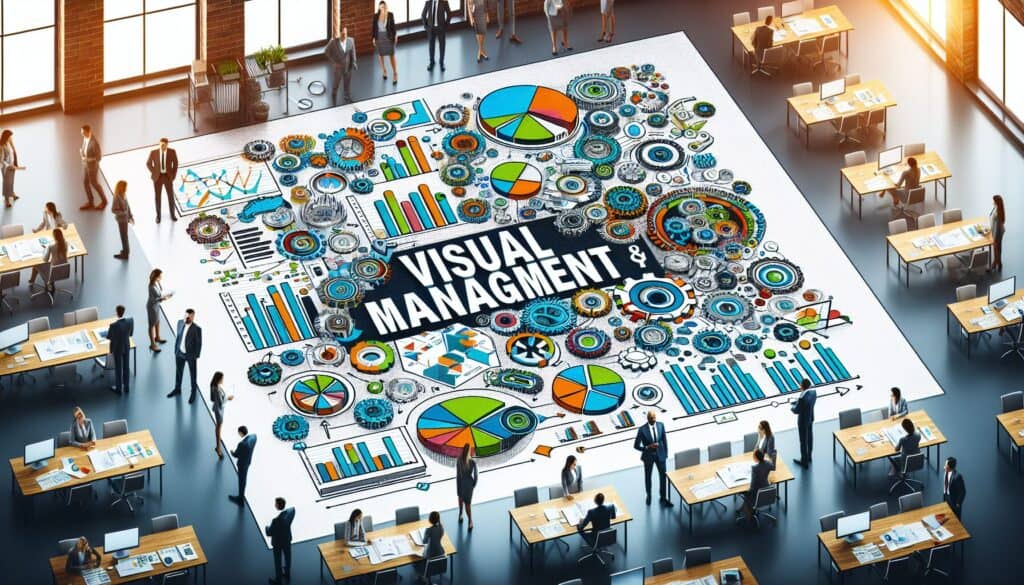To make information about processes, performance, standards, and problems immediately apparent and easily understandable to everyone in the workplace.
- Methodologies: Engineering, Quality
Visual Management

Visual Management
- Andon System, Continuous Improvement, Key Performance Indicator (KPI), Lean Manufacturing, Process Improvement, Process Mapping, Quality Control, Quality Management, Visual Design
Objective:
How it’s used:
- Uses visual tools such as charts, graphs, color-coding, dashboards, shadow boards, and Andon lights to display critical information in real-time, enabling quick identification of abnormalities and facilitating rapid response.
Pros
- Improves communication and transparency; Facilitates quick problem identification and decision-making; Enhances employee engagement and accountability; Supports standardization and continuous improvement.
Cons
- Can lead to information overload if not well-designed or focused; Visuals can become outdated if not diligently maintained; May require initial investment in displays and materials; Effectiveness depends on a supportive culture that acts on the visual cues.
Categories:
- Human Resources, Lean Sigma, Manufacturing, Project Management, Quality
Best for:
- Communicating key information clearly and concisely using visual signals to enable immediate understanding and action in the workplace.
Visual Management is widely applicable in industries such as manufacturing, healthcare, logistics, and project management, where clear communication of processes and performance is necessary. For instance, in a manufacturing environment, shadow boards can be utilized to ensure that tools are returned to designated places, enhancing organization and efficiency on the shop floor. The use of Andon lights alerts operators and management to the status of production lines, facilitating immediate response to issues, thereby reducing downtime. In project management, dashboards can encapsulate project milestones and deadlines, enabling teams to visually track progress and make data-driven decisions quickly. This methodology thrives during phases where rapid response is needed, such as during problem-solving sessions or continuous improvement initiatives. Participants typically include team members across various levels, including frontline workers, supervisors, and management, ensuring a collaborative approach to identifying and solving abnormalities. Training in visual management techniques can further enhance employee engagement, as staff are encouraged to take ownership of their workspaces and contribute to standardization processes. This approach not only improves transparency within organizations but also encourages an environment where continuous improvement is actively pursued, leading to better performance outcomes and a more cohesive team dynamic.
Key steps of this methodology
- Identify key performance indicators (KPIs) relevant to operations.
- Select appropriate visual tools (charts, dashboards, etc.) for displaying information.
- Design a visual layout that prioritizes clarity and immediate comprehension.
- Establish a system for real-time updates to ensure information accuracy.
- Implement color-coding or symbols to denote status and urgency.
- Train team members on interpreting visual signals and responding to them.
- Regularly review and adjust visual tools based on feedback and changing needs.
- Promote a culture where visual management is used as a standard practice.
Pro Tips
- Incorporate real-time data inputs into dashboards, allowing for dynamic updates that reflect current conditions and drive immediate decision-making.
- Utilize color gradients and symbols on visual tools to represent data trends and variances, enabling users to quickly assess performance against benchmarks.
- Implement regular reviews and updates of visual management systems, ensuring relevancy and effectiveness in aligning with evolving objectives and processes.
To read and compare several methodologies, we recommend the
> Extensive Methodologies Repository <
together with the 400+ other methodologies.
Your comments on this methodology or additional info are welcome on the comment section below ↓ , so as any engineering-related ideas or links.
Historical Context
1986
(if date is unknown or not relevant, e.g. "fluid mechanics", a rounded estimation of its notable emergence is provided)

Related Posts
METS to Calories Calculator
Meta-Analysis
Message Mapping
Mental Model Diagrams
Maximum Acceptable Pushing and Pulling Forces
Material Requirements Planning (MRP)